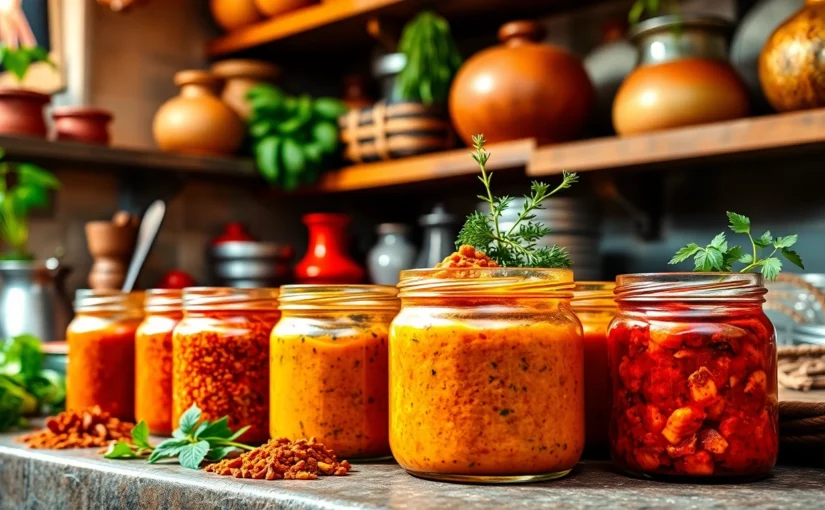Understanding the Fundamentals of Curry Paste and Its Industry Significance
What is Curry Paste and Its Culinary Significance
Curry paste stands as the cornerstone of authentic and flavorful dishes across various cuisines, particularly in Indian, Thai, and Southeast Asian culinary traditions. It is a concentrated blend of ground spices, herbs, and other ingredients that serve as the flavor base for a multitude of dishes. Unlike individual spices, curry paste combines these elements into a harmonious mixture, allowing chefs and home cooks to infuse complex flavors into their recipes efficiently.
The significance of curry paste lies in its ability to develop layered flavors that can transform simple ingredients into culinary masterpieces. It offers versatility, allowing it to be used in curries, soups, stews, and marinades. Moreover, mass production and export of high-quality curry paste, such as the offerings from Curry Paste manufacturers, have made authentic flavors accessible globally, enriching international cuisines and catering to the rising demand for exotic tastes.
Common Ingredients Used in Authentic Curry Pastes
Authentic curry pastes are crafted with a meticulously selected combination of ingredients that define their unique characteristics. Key components include:
- Spices: Such as cumin, coriander, turmeric, paprika, and fenugreek, providing depth and warmth.
- Herbs: Fresh or dried herbs like coriander leaves, basil, and lemongrass, adding freshness and aroma.
- Chilies: For spiciness and color, ranging from mild to fiery varieties.
- Garlic and Ginger: Core flavor enhancers that also impart health benefits.
- Other ingredients: Tamarind, vinegar, or coconut milk to add tanginess or creaminess.
Quality production emphasizes sourcing organic and natural ingredients, ensuring the end product is both authentic and healthful. Modern manufacturers incorporate advanced techniques to preserve flavor integrity while maintaining product safety.
Differences Between Homemade and Commercial Curry Pastes
The debate between homemade and commercial curry pastes centers on convenience versus authenticity and consistency. Homemade curry pastes offer customization, allowing cooks to adjust spice levels, ingredients, and flavors to personal preference. They are often made fresh, with control over quality and purity, which appeals to health-conscious consumers.
Conversely, commercial curry pastes—such as those produced by Spice Nest—provide consistency, longer shelf life, and ease of use for busy households and restaurateurs. These products undergo rigorous manufacturing standards, ensuring safety, and are often certified with quality marks to meet international export standards. They are designed for scalability, allowing mass production without compromising flavor or quality.
For industry players, the key is to bridge the gap by offering premium, artisan-style commercial curry pastes that retain the depth of homemade recipes while providing the convenience and safety of processed products.
Manufacturing and Exporting High-Quality Curry Paste
Key Quality Standards and Certifications for Curry Paste Production
To excel in the international market, manufacturers like Spice Nest adhere to stringent quality standards and certifications. These include ISO 22000 for food safety management, HACCP protocols for hazard analysis, and Organic certifications if the product claims organic ingredients.
Certification by national and global regulatory bodies assures clients of product safety, hygiene, and consistency. These certifications are critical in building trust with international buyers, especially when exporting to markets with strict import regulations such as the European Union, USA, and Middle Eastern countries.
Moreover, compliance with standards like FSSAI (Food Safety and Standards Authority of India) and GMP (Good Manufacturing Practices) ensures that each batch meets safety, cleanliness, and quality benchmarks.
Packaging and Preservation Techniques for Export Markets
Packaging plays a pivotal role in preserving the flavor, aroma, and shelf life of curry pastes. Modern packaging techniques include vacuum sealing, nitrogen flushing, and airtight containers, which prevent oxidation and microbial growth.
Attractive and informative packaging also serves as a marketing tool, highlighting product authenticity, certifications, and usage instructions. Spice Nest’s approach involves eco-friendly and tamper-proof packaging solutions that cater to global consumers’ environmental consciousness and safety concerns.
Proper labeling, including ingredient lists, expiry dates, batch numbers, and country of origin, ensures compliance with import regulations and boosts consumer confidence.
Global Market Trends and Demand for Curry Pastes
The global appetite for diverse and authentic flavors continues to grow, bolstered by increasing international travel, culinary tourism, and globalization. According to recent market research, the worldwide spice and condiment market is projected to reach several billion USD by 2028, with curry pastes occupying a significant share.
Consumers are increasingly seeking organic, preservative-free, vegan, and gluten-free options, prompting manufacturers to innovate accordingly. Trends indicate a rise in convenient, ready-to-use products that retain traditional flavors while catering to modern lifestyles.
As a leading exporter, Spice Nest continually adapts to these trends by expanding its product range to include organic curry pastes, organic ingredients, and innovative flavors, thus strengthening its market position.
Best Practices for Incorporating Curry Paste into Culinary Creations
Tips for Achieving Perfect Flavor and Consistency
Optimal use of curry paste depends on understanding its flavor profile and application. For a balanced taste:
- Start with small quantities and gradually increase to suit the dish.
- Sauté the paste in oil at the beginning of cooking to release aromas and enhance flavor.
- Adjust cooking time to allow the flavors to develop fully, often simmering for 20-30 minutes.
- Combine with ingredients like coconut milk, yogurt, or stock to balance spiciness and thickness.
Consistency is achieved by controlling cooking time and ingredient proportions, ensuring the paste integrates seamlessly into the dish.
Integrating Curry Paste Across Various Cuisines and Dishes
While traditionally Indian and Southeast Asian dishes leverage curry paste, modern culinary experimentation invites its use in Western cuisines — for example, in fusion recipes like curry-flavored burgers, pasta sauces, or even salad dressings. It can serve as a marinade for meats or vegetables, or as a base for soups and stews.
For Indian dishes, curry paste simplifies complex recipes, enabling home cooks to prepare rich gravies like Palak or Veg Kolhapuri with ease. In Thai cuisine, red and green curry pastes form the backbone of curries with vibrant flavors. Understanding regional differences helps in choosing the appropriate paste variant, each with its unique spice blend.
Health Benefits and Nutritional Aspects of Curry Pastes
Modern curry pastes, especially those from reputable manufacturers, often feature health-enhancing ingredients like turmeric (rich in curcumin), garlic, ginger, and chili peppers. These components possess anti-inflammatory, antioxidant, and metabolism-boosting properties.
Using natural and preservative-free pastes maximizes nutritional benefits. Additionally, organic options reduce exposure to pesticides and artificial chemicals, aligning with wellness trends. Incorporating curry paste into diet can contribute to improved digestion, immunity, and overall well-being.
Strategic Approaches to Market Promotion of Curry Paste
Effective Branding and Packaging for Competitive Advantage
Creating a compelling brand identity involves highlighting authenticity, quality certifications, and unique flavor profiles. Packaging should reflect these qualities through vibrant visuals, transparent windows, and eco-friendly materials. Labels should clearly communicate ingredients, certifications, and usage tips, fostering trust.
Innovative packaging solutions, like resealable pouches or portion-controlled jars, enhance user convenience. Leveraging storytelling about sourcing, traditional recipes, or health benefits can differentiate the product in crowded markets.
Participating in Food Exhibitions and Trade Shows
Exhibitions like Biofach exemplify the platform where Spice Nest has showcased its curry pastes successfully, expanding global footprints. Participation helps in networking with distributors, retailers, and culinary professionals, allowing direct feedback and market insight.
Preparing attractive displays, sampling, and promotional materials can significantly boost brand visibility. Regular attendance at international trade fairs aligns with growth strategies and keeps the brand aligned with industry innovations.
Leveraging Digital Marketing for Global Reach
E-commerce and social media platforms offer unprecedented access to global consumers. Developing engaging content, recipe videos, and user testimonials can build brand loyalty. Search engine optimization (SEO) centered around keywords like “Curry Paste” enhances online visibility.
Collaborating with food bloggers, chefs, and influencers can amplify reach. Maintaining an active online presence ensures customers are informed about new product launches, certifications, and participation in upcoming food shows.
Future Outlook and Innovations in the Curry Paste Industry
Emerging Flavors and Organic Options
The industry anticipates a surge in organic, additive-free curry pastes catering to health-conscious consumers. Innovations include regional specialty blends, vegan formulations, and low-sodium variants. Fusion flavors combining traditional spices with modern tastes, such as lemon grass or basil infusions, are gaining popularity.
Technological Advances in Manufacturing
Automation, vacuum processing, and cryogenic grinding improve consistency and preserve flavor quality in manufacturing. These advances reduce contamination risks and extend shelf life without preservatives. Such innovations allow producers to scale efficiently while maintaining premium quality.
Sustainability and Eco-Friendly Practices
As environmental concerns escalate, manufacturers are adopting sustainable sourcing, biodegradable packaging, and energy-efficient processes. Promoting organic farming and fair-trade practices enhances brand reputation and appeals to eco-conscious consumers. Companies committed to sustainability can leverage these values as part of their marketing strategy to stand out in the competitive landscape.

